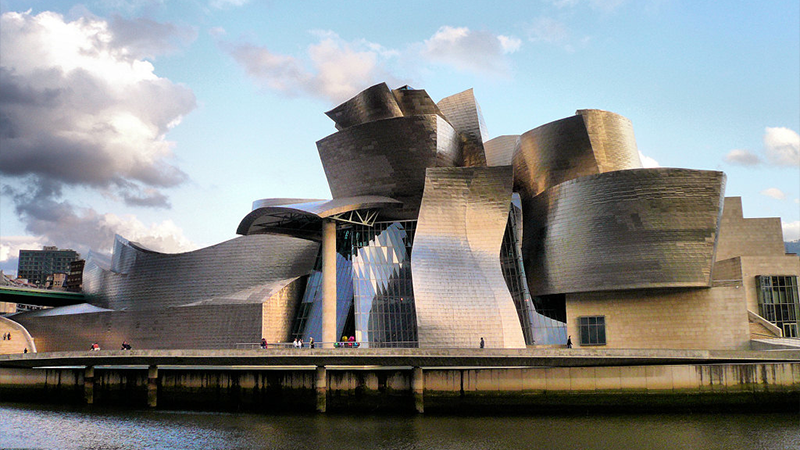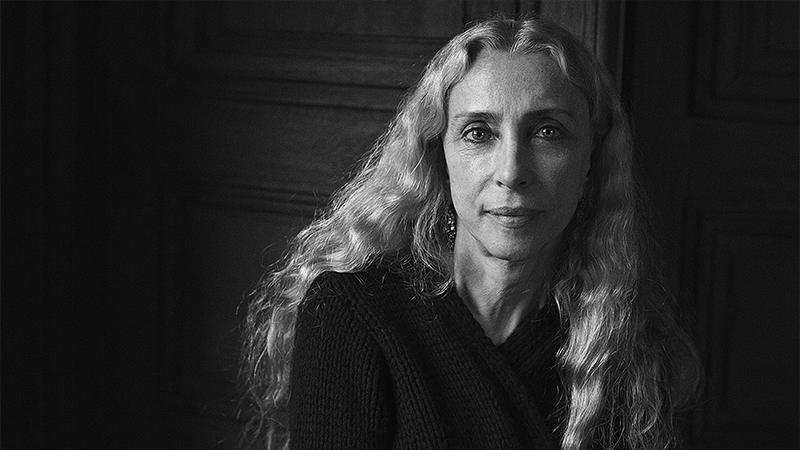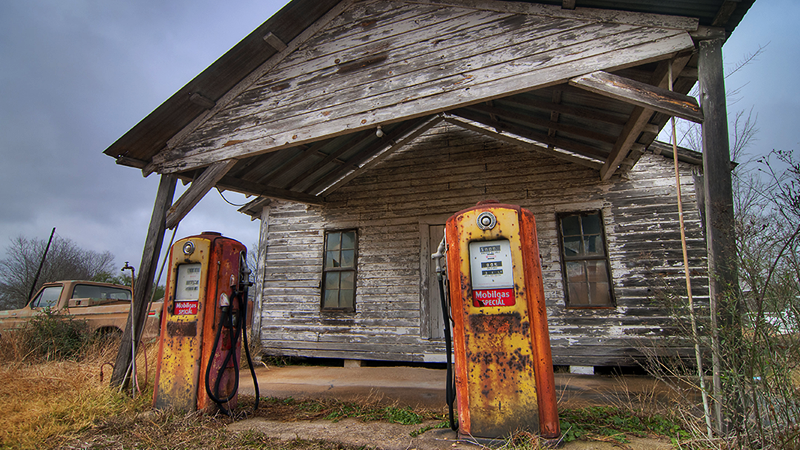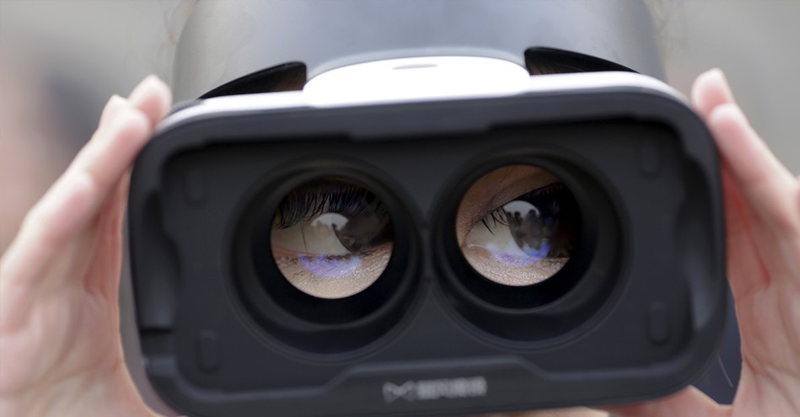The Guggenheim Museum in Bilbao is the world’s largest toy. Set among the drab streets of this rather depressing Spanish port, it throws up a fountain of light and good cheer that promises all the fun of a travelling circus – erecting its tent beside a disused railway yard in a run-down industrial city.. In its own, self-defining way it is a masterpiece, and the fact that it is an art gallery is almost wholly irrelevant. The one thing that someone visiting the Bilbao Guggenheim can forget about is any thought of actually entering the building. Stay outside it – at a distance of about one hundred yards – and you will absorb all its audacity, magic, good humour and genius. And its infantilising charm. This is Disneyland for the media studies PhD.
Walking from the centre of Bilbao, take the Calle Iparraguirre, and it will lead you straight to the entrance of the Guggenheim, guarded by Jeff Koons’ flower-bedecked “Puppy”, another toy that points to the real role of Frank Gehry’s extraordinary structure. Even at a distance, beyond the cafe tables and traffic and overhead wires, the visual spectacle stops everything else going on in your mind. Cascades of golden light overpower the sun, rising from a jumble of massive titanium forms piled on top of each other, part train crash and part explosion in a bullion vault. If the atomic bomb inside Fort Knox had exploded in James Bond’s face at the end of Goldfinger, the result would have been very much like the Bilbao Guggenheim.
Standing in the welcome shade of Koons’ Puppy, and shielding your eyes from the glare, you first try to make sense of all this glowing geometry in traditional architectural terms. But it’s obvious from the start that there are no deferential nods to Egyptian, classical, modernist or postmodernist modes, no reassuring “quotes” like the over-cute pilasters that adorn the extension to London’s National Gallery by Robert Venturi and Denise Scott Brown. Gehry’s Guggenheim is completely new, shrugs off the past and exists solely in a kind of imaginary future. In some ways the building is the larval stage of a new kind of architecture that will emerge from its chrysalis and finally take wing a hundred years from now.
The museum is built on sloping ground that runs down to the river Nervión, a vile-looking creek that must be the most gloomy stretch of water after the Styx. Gehry’s heart will have sunk when he first saw the site beside this grim stream and the nearby railway yard. Rarely among museums, the Bilbao Guggenheim is entered by a descending flight of steps, and by the time they have circled the 19 galleries, most visitors – who, when I was there, had to queue for an hour – are too exhausted to do anything but flake out in the pleasant cafe beside the entrance. Surrounded by glass panels and comfortable limestone walls, they are missing the best view of the museum, which is from the far side of the river, a Styx with a matchless prospect and the promise of a return trip.
From Koons’ Puppy, turn left, and follow the road as it curves around the museum to the bridge. Stop when you have crossed the Nervión, and you will see the Bilbao Guggenheim in all its gilded magnificence, its immense and slightly baggy volumes reflected in the river and the ornamental pools of the plaza that separates the museum from the water’s edge. Within a few minutes the confusing and apparently random shapes that form the structure may begin to make sense, as your eye learns a new kind of language. Bilbao is a great sea-port: is its new museum a ship in disguise, a spectral memory of the great caravels that carried gold back from the New World to enrich Spain half a millennium ago?
Now, of course, the Americas have sent a gold-hunter of their own, the privateering brand Guggenheim, diversifying into multiples and merchandising, and the booty will be going back across the Atlantic. The Bilbao Guggenheim is a treaty port negotiated with the burghers of this rather down-at-heel city, part bullion vault and part glimmering mirage to cow and dazzle the natives.
Gazing across the river at this metallisation of a dream, one has to take one’s hat off to Gehry and the civic leaders of Bilbao. I’m impressed by Tate Modern and its vast Turbine Hall, with its echoes of Albert Speer and the Zeppelin field rallies, and its immense popularity proves that it satisfies a need that should have been met by the disastrous Millennium Dome, a wish for an uplifting social space more enduring than the local Tesco or Ikea.
At the same time, it would have been a powerful tonic for post-2000 London if something as original and disorienting as the Bilbao Guggenheim occupied the site of the old power station. But would we have had the nerve to gamble on Gehry’s visionary dream? Could we justify to our rather conventional and timid selves a work of architecture so original and so cut off from our beloved past of pitched roofs and Tudor beams? Are we ever really happy with an architecture that unsettles and provokes?
More to the point, I wonder if the Bilbao Guggenheim is a work of architecture at all? Perhaps it belongs to the category of exhibition and fairground displays, of giant inflatables and bouncy castles. The Guggenheim may be the first permanent temporary structure. Its interior is a huge disappointment, and confirms the suspicion that the museum is a glorified sales aid for the Guggenheim brand. There is a giant atrium, always a sign that some corporation’s hand is sliding towards your wallet, but the galleries are conventionally proportioned, and one can’t help feeling that they are irrelevant anyway. The museum is its own work of art, and the only one really on display. One can’t imagine the Mona Lisa, the Venus de Milo, or Picasso’s Guernica ever being shown here. There would be war in heaven. Apart from anything else, these works have a dimension of seriousness that the Guggenheim lacks. Koons’ Puppy, faithfully guarding the entrance to the enchanted castle, gives the game away. Architecture today is a visitor attraction, deliberately playing on our love of the brightest lights and the gaudiest neon. The Bilbao Guggenheim’s spiritual Acropolis is Las Vegas, with its infantilising pirate ships and Egyptian sphinxes. Gehry’s museum would be completely at home there, for a year at least, and then look a little dusty and jaded, soon to be torn down and replaced by another engaging marvel with which our imaginations can play.








